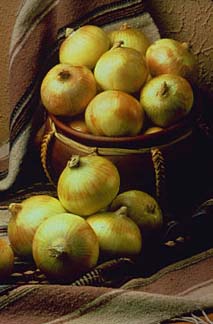 What makes Texas SpringSweet and Texas 1015 SuperSweet Onions so unique?
What makes Texas SpringSweet and Texas 1015 SuperSweet Onions so unique?Texas SpringSweet and Texas 1015 SuperSweet Onions are thin-skinned, sweet and juicy. And they have low levels of the tear-causing chemical pyruvate, so slicing, dicing, cooking and eating Texas sweet onions is all the more enjoyable.
How big are Texas SpringSweet and Texas 1015 SuperSweet Onions?
Texas SpringSweet and Texas 1015 SuperSweet Onions come in a variety of sizes. The smallest range from 1 inch to 2 1/4 inches in diameter, and the heftiest regularly check in at 3 3/4 inches or larger in diameter.
How should these onions be stored?
Hold your Texas sweet onions at 55-58 degrees F and keep dry. To preserve the moist tastefulness of these bulbs, drop them individually in a pair of pantyhose, tying a knot between each sweet onion. Hanging the nylon onion strands allows for sufficient ventilation and a longer-lasting, tastier sweet onion.
What type of plant is the onion?
The onion is part of the lily family. Onion kin include asparagus, tulips and yuccas.
Besides its anti-carcinogen properties, how else do Texas sweet onions benefit us?
History's earliest records show man using onions as a treatment for artery disease, arthritis, asthma, bronchitis, high blood pressure, dysentery and the common cold. We know now that compounds in onions can function as anti-coagulants, cholesterol modifiers and antibiotics.
How long have onions been around?
Onions probably originated on the high plateaus of southeast Europe. Once they were brought to the "Fertile Crescent" of Assyria, Sumeria, Babylonia and Egypt, their use increased significantly and spread dramatically.